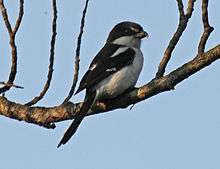Southern fiscal
| Southern fiscal | |
|---|---|
 | |
| Scientific classification | |
| Kingdom: | Animalia |
| Phylum: | Chordata |
| Class: | Aves |
| Order: | Passeriformes |
| Family: | Laniidae |
| Genus: | Lanius |
| Species: | L. collaris |
| Binomial name | |
| Lanius collaris Linnaeus, 1766 | |
| Subspecies | |
|
see text | |
The southern fiscal or fiscal shrike (Lanius collaris) is a member of the shrike family found through most of Sub-Saharan Africa. It is also sometimes named jackie hangman or butcher bird due to its habit of impaling its prey on acacia thorns to store the food for later consumption. It was previously lumped together with the northern fiscal (Lanius humeralis).[2] Together they were known as the common fiscal.
Identification
This is a fairly distinctive 21–23-cm long passerine with white underparts and black upperparts extending from the top of the head down to the tail. The bird has a characteristic white "V" on the back and a relatively long black tail with white outer feathers and white tips on the other feathers. The bill, eyes and legs are black. Adult male and female common fiscals are quite similar except for the rufous lower flank of the female.
Subspecies
- L. c. aridicolus Clancey, 1955 – south western Angola and north western Namibia (dune-fog zone of the Namib Desert)
- L. c. collaris Linnaeus, 1766 – extreme southern Namibia, southern, central and eastern South Africa, Swaziland, Lesotho, and extreme southern Mozambique (Maputo)(except the south), Zambia, northern Botswana, and possibly also extreme south western Tanzania and extreme north eastern Namibia
- L. c. marwitzi Reichenow, 1901 Uhehe fiscal – north eastern, central and south eastern Tanzania, northern Malawi
- L. c. pyrrhostictus Holub & Pelzeln, 1882 – extreme north eastern Botswana (around Basuto), southern Zimbabwe (south of Harare), north eastern and eastern South Africa (Limpopo and Mpumalanga), and south western Mozambique (almost restricted to Gaza province)
- L. c. subcoronatus A. Smith, 1841 – extreme south east Angola, Namibia (excluding the coastal north west and extreme south), Botswana, south western Zimbabwe, and northern South Africa (south to north western Northern Cape and central Free State)
Habits
The southern fiscal is usually solitary and hunts insects and small rodents from an exposed perch or the tops of shrubs. Territorial size is directly related to the density of hunting perches. Installing more artificial perches causes the fiscal to reduce its territory size and allow more birds in the affected range.
Habitat
The southern fiscal lives in a wide range of habitats from grassland with fences for perching to acacia thornveld or even woodland, but avoids very dense habitats where its hunting would be impaired.
Call
It gives a jumbled mix of shrike-like swizzling sounds including some imitations and a harsh Dzzzttt-dzzzt-dzzzt alarm call. Most of those calls however are either threatening or alarm calls. The species sometimes produces a surprisingly sweet, quiet song, although such song, however sweet it sounds, generally is either territorial or pair-bonding in function.[3]
References
- ↑ BirdLife International (2012). "Lanius collaris". IUCN Red List of Threatened Species. Version 2013.1. International Union for Conservation of Nature. Retrieved 2013-07-10.
- ↑ Bowie, Rauri; Crowe, Tim; Voelker, Gary. "Systematics and Biogeography, Comparative phylogeography of southern African birds" (PDF). Annual Report January – December 2009, Research Programmes & Initiatives. Percy FitzPatrick Institute, University of Cape Town. Retrieved 24 August 2016.
- ↑ Konrad Lorenz (15 April 2013). King Solomon's Ring. Routledge. ISBN 978-1-134-49892-5. Retrieved 21 September 2013.
- Ian Sinclair, Phil Hockey and Warwick Tarboton, SASOL Birds of Southern Africa (Struik 2002) ISBN 1-86872-721-1
External links
 Media related to Lanius collaris at Wikimedia Commons
Media related to Lanius collaris at Wikimedia Commons- Species text - The Atlas of Southern African Birds
- Videos, photos and sounds - Internet Bird Collection
